The Ultimate Chuck Taylor Sneaker Review: How to Clean, Style, and Work Out
God damn, I love Chuck Taylor All Stars.
By the end of this review, you will too.
They’re timeless, they’re stupid versatile, they look better with age, they come in every color imaginable, you can buy them anywhere on Earth, and they’re actually surprisingly good for working out in. (Well, for some types of working out — more on that below.)
Converse sells 100 million pairs of Chuck Taylors every year and 60 percent of all Americans either own or have owned a pair in their lifetime. Since I bought my first pair at age 17 I’ve worn through more pairs than I can count, and here we’re discussing why they are indisputably the most iconic sneaker of all time. I don’t care about Superstars, I don’t care about Jordans, the Converse Chuck Taylor is where it’s at.
Further Reading
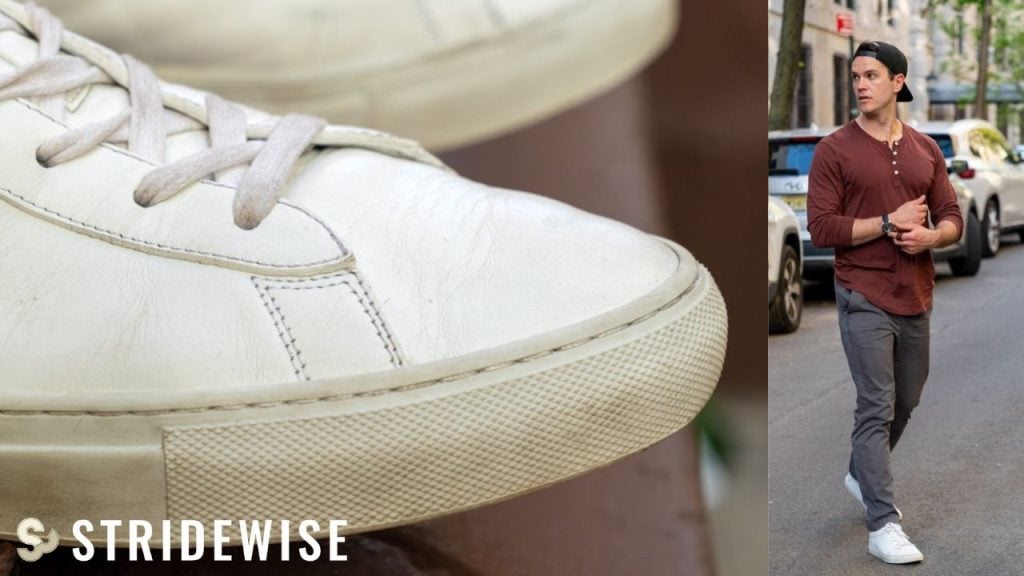
The 10 Best Leather Sneakers for Men
No matter your age or style preference, a man’s wardrobe is not complete unless it has a pair of leather sneakers. We tried many out there and here are our top 10. Check out the list →
This is the most beloved luxury sneaker on the market. With a minimalist look, sleek profile, and soft Napa leather, many consider it the ultimate white sneaker.
History of the Chuck Taylor Sneaker
- Began as a basketball shoe in the 1920s
- Became the official training shoe of the Olympics and the U.S. Army
- Declined in popularity until its resurgence in 1980s as a retro icon
- Bought by Nike in 2003
Back in the 1920s, Akron Firestone’s player Chuck Taylor asked Converse to make a basketball shoe with more ankle support and sole flexibility, and when it was first released with his name emblazoned on the ankle, it didn’t look quite as cool as the shoe you see today:

The “All-American Basket-Ball Shoe” was the first shoe to receive a celebrity athlete’s endorsement — paving a clear path for Nike’s Jordans decades later — and after Taylor promoted the shoe around the nation at YMCAs and college gyms, it exploded in popularity and became the U.S. Armed Forces’ official athletic training shoe during World War 2 and the official shoe of the Olympic Games from 1936 to 1968.
By the 1960s, the shoe had over 70 percent of the market on basketball shoes, although its popularity began to decline in the 1970s as technology improved and players began preferring shoes with leather uppers and harder rubber soles. 1982 was the last time an NBA player wore a Chuck Taylor shoe (and those were made of leather), but the 80s and 90s were when the shoe experienced a resurgence in popularity as a retro icon and as casual wear, becoming a favorite of skaters, musicians, and eventually, just about everyone.
Nike bought Converse in 2003 for a little over $300 million, but ever since the shoe’s inception in the ’20s, the design has barely changed at all. So what’s it made from?

Converse Chuck Taylor All Star Construction
- Cotton canvas upper
- Double stitching
- Vulcanized rubber sole
- Rubber toecap
It’s a pretty simple shoe, which of course is a big part of its appeal.
The label just says everything is textile, but they’re made from cotton canvas, which is a durable, plain-woven fabric that’s used in sails, backpacks, tents, and sneakers. The canvas is breathable and lightweight, and while it doesn’t have a lot of shape to it — this is a very floppy, unstructured, low volume kind of shoe — it makes for terrific summer wear.
Another pro of the canvas is that it’s easy to draw or paint on, which countless customers have done over the years to make for more personalized sneakers.

There’s double stitching along the upper and of course, the famous Chuck Taylor All Star logo glued on the ankle of the high top models.
Everything about this shoe is iconic. The All Star logo, yes, but also the white rubber toecap that untold companies have imitated. Not many notice this, but there’s also a strip of rubber running along the sole under the toe, which helps with durability if your drag your toes like I do.
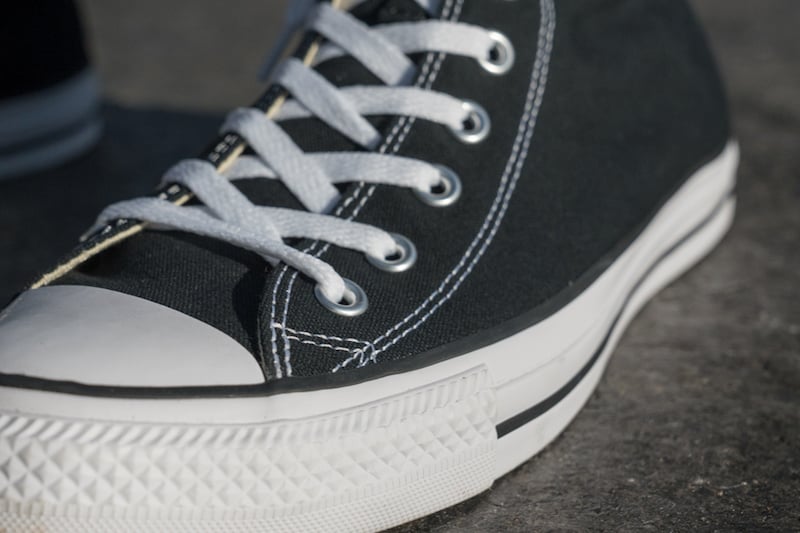
Converse Chuck Taylor All Star Sole
- Vulcanized rubber outsole
- Heat treated to affix to the upper
- Decent shock absorption, not much arch support
There’s just one layer to the sole, which is heat treated to stick it to the upper, and it’s made from rubber. On top of the rubber there’s an insole that can’t be removed without holding the shoe to a hairdryer and waiting for the glue to come unstuck. The insole isn’t that squishy and doesn’t provide much arch support, but it does help to improve the shock absorption.
The outsole is vulcanized, which is a method of hardening rubber so that it’s harder, more durable and can withstand more wear and tear than a lot of other rubber soles. That said, don’t expect extreme longevity in your Chuck Taylors. I’ve worn them all my life and with regular wear, I’ve found myself purchasing a new pair every year to two years, max.

Converse Chuck Taylor Fit & Sizing
- Fits true to size
- Some prefer to size down half a size for tighter fit
- Flat sole, little arch support
Sizing is a controversial component of Chucks. I find that they fit true to size just fine — I’m an 11.5 on a Brannock device (that’s the sizing device you’ll find in shoe stores) and an 11.5 fits me in Chucks. Unfortunately, they aren’t friendly on wide feet.
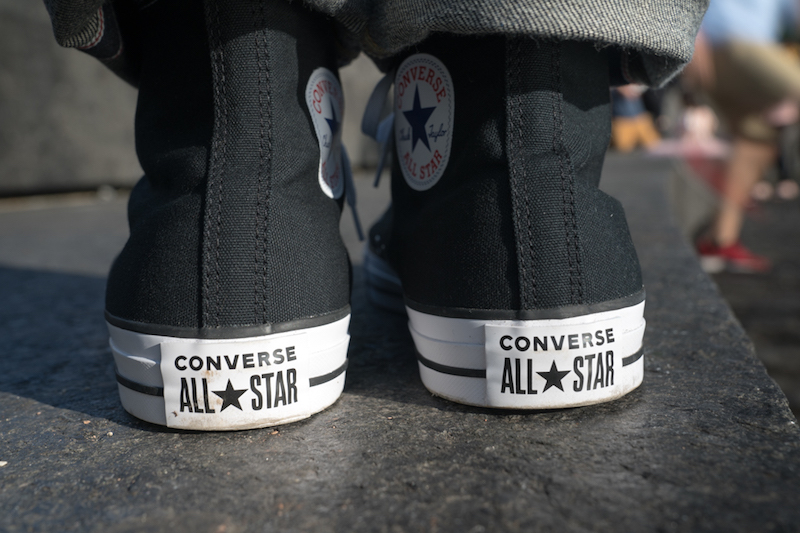
These are some of the most basic, uncomplicated, low tech shoes on Earth, so they’re comfortable but they’re not supportive. The arch support is all but non-existent, which means it’s not a great shoe for folks with flat feet who need extra arch support, but if you do need arch support then you can use an orthotic from Powerstep, which slips pretty easily into the shoe.
Despite the lack of arch support the shoes are indeed lightweight, the insole does a decent job of absorbing shock, and although few people in their right mind would use Chucks to run or play basketball today, now that there are more advanced sneakers available.
But surprisingly, there’s one type of exercise that Chucks are perfect for.
[Related: Chuck 70 vs All Star | Which Is the Best Converse Sneaker?]
View this post on Instagram
How to Work Out in Chuck Taylors
- Flat sole is ideal for powerlifting
- Easy to grip sole and maintain tripod position
- Rubber sole doesn’t squish too much under heavy weight
- Not great for running/basketball
Many people are surprised that Chuck Taylors are ideal for lifting weights. Not for basketball, not for running, but if you’re doing squats and deadlifts then Chuck Taylors are perfect — every powerlifter on Earth has maxed out in a pair of Chucks. Above is Dylan Hellriegel becoming the first man to ever squat 1,000 pounds and deadlift 900 pounds in the same competition. And he did it in a trusty pair of Chuck Taylors.
Why is it so great for lifting barbells? Because it has a flat sole with no elevated heel, and the flatness makes it easier to splay the toes, grip the sole, and maintain the tripod position — that’s the heel, medial, and lateral side of the metatarsal base — and the hard rubber is very resistant to compression.
When lifting weight and putting weight into the heel and forefoot while gripping the floor, the last thing you want is a rubber outsole that’s going to squish and absorb too much force, shift your weight, and cause your torso to collapse. The hard, flat outsoles of a trusty pair of Chucks can help you maintain lifting mechanics and correct form.
So if you want to get stronger, or on the other hand, if you already own a pair of Chucks, take ’em to the gym and get under the bar. If that’s your main goal, consider sizing down half a size so they’re nice and tight.
How to Clean Chuck Taylor All Stars
- Clean with baking soda and vinegar
- Nail polish remover can work
- Upper is machine washable
Now I’m not about to recommend using shoe trees or anything for these sneakers.
But the main question people have is how to keep the white rubber clean. Some use nail polish remover, some use WD-40, but you can keep your Chucks pearly white with two ingredients you probably have in your kitchen:
- 2 parts baking soda
- 3 parts vinegar
Mix them up in a bowl, but make sure you don’t use a metal spoon and make sure no metal gets into the mixture, as it can react with the vinegar. It’ll fizz into a paste, put some on a toothbrush, and scrub away. Here’s a before and after from my own shoes.

Easy. The rest of the shoe is machine washable, so throw ’em in your washing machine whenever you want. It’s made of cotton, there’s not a lot you can ruin, just make sure you untie the shoes when you put them on if you want to avoid tearing the canvas.
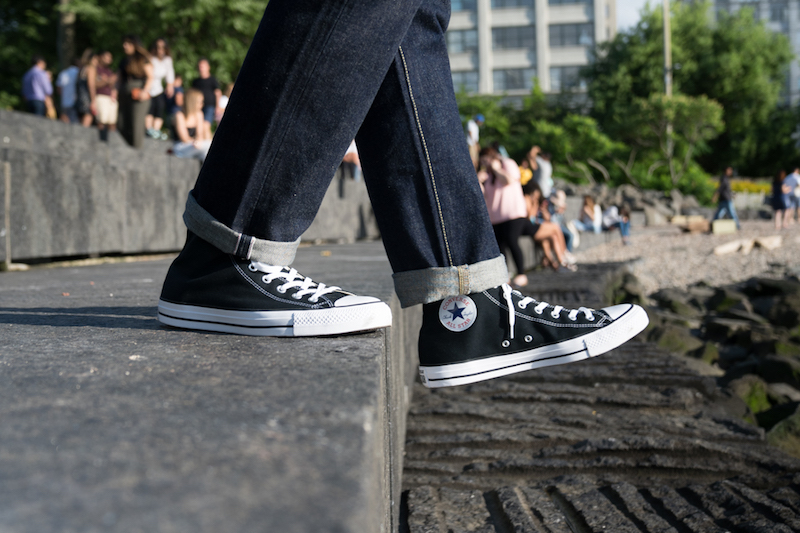
Converse Chuck Taylor All Star Price
- Buy the shoes on Converse here for $65, in dozens of colors
- The low cut version is a hair cheaper at $60

Converse Chuck Taylor All Star Pros and Cons
Pros
- Timeless, they’re damn cool shoes
- They look cool when they’re beaten up
- Inexpensive
- Comfortable
- Available in dozens of colors
- Versatile
Cons
- Sole wears through in a year or two
- Not great arch support
- Not warm
- Sole isn’t as flexible as some sneakers (eg. those with air blown rubber)
- Not great for most workouts

Cards on the table: I love Chuck Taylors. They go with anything, they look as good when they’re old as they do when they’re new, they’re lightweight, they’re breathable, they’re timeless, they’re easy to clean, and they’re so damn iconic. They just define the word “sneaker.”
Even though Rocky Balboa ran up the steps of the Philadelphia Museum of Art in just about all of his movies, they’re not the best for running or for most sports. They wear through in a year or two. They have no volume — everyone’s foot looks flat as a board in these shoes.
But they’re under a hundred bucks, and while some competitors might cost ten or so bucks less, the cost is worth it for their cultural cachet and the fact that you’ll never run out of outfits to wear them with.
Chuck these on.

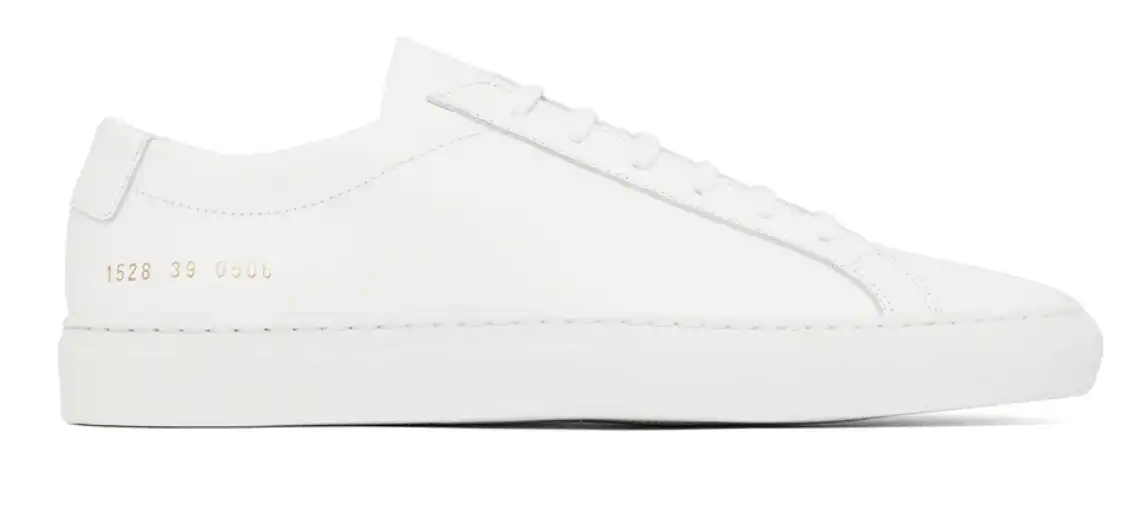


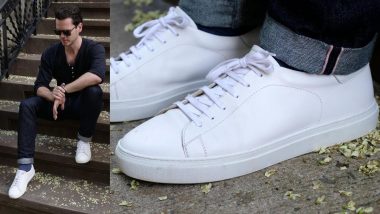
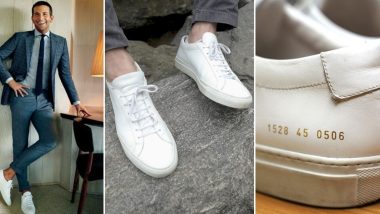

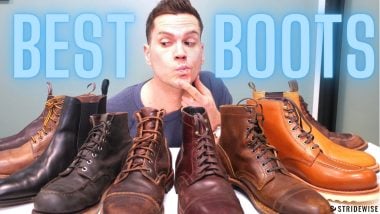
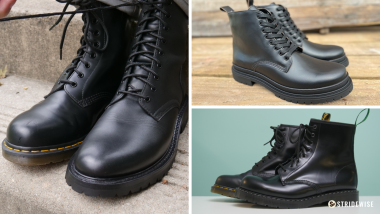


Join the Discussion